英语基础语法
英语基础语法大全
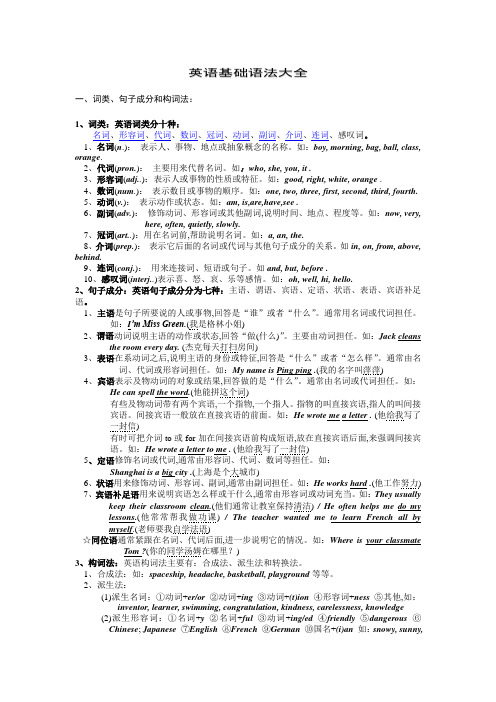
英语基础语法大全一、词类、句子成分和构词法:1、词类:英语词类分十种:名词、形容词、代词、数词、冠词、动词、副词、介词、连词、感叹词。
1、名词(n.):表示人、事物、地点或抽象概念的名称。
如:boy, morning, bag, ball, class, orange.2、代词(pron.):主要用来代替名词。
如:who, she, you, it .3、形容词(adj..):表示人或事物的性质或特征。
如:good, right, white, orange .4、数词(num.):表示数目或事物的顺序。
如:one, two, three, first, second, third, fourth.5、动词(v.):表示动作或状态。
如:am, is,are,have,see .6、副词(adv.):修饰动词、形容词或其他副词,说明时间、地点、程度等。
如:now, very,here, often, quietly, slowly.7、冠词(art..):用在名词前,帮助说明名词。
如:a, an, the.8、介词(prep.):表示它后面的名词或代词与其他句子成分的关系。
如in, on, from, above, behind.9、连词(conj.):用来连接词、短语或句子。
如and, but, before .10、感叹词(interj..)表示喜、怒、哀、乐等感情。
如:oh, well, hi, hello.2、句子成分:英语句子成分分为七种:主语、谓语、宾语、定语、状语、表语、宾语补足语。
1、主语是句子所要说的人或事物,回答是“谁”或者“什么”。
通常用名词或代词担任。
如:I’m Miss Green.(我是格林小姐)2、谓语动词说明主语的动作或状态,回答“做(什么)”。
主要由动词担任。
如:Jack cleansthe room every day. (杰克每天打扫房间)3、表语在系动词之后,说明主语的身份或特征,回答是“什么”或者“怎么样”。
英语基础语法知识大全
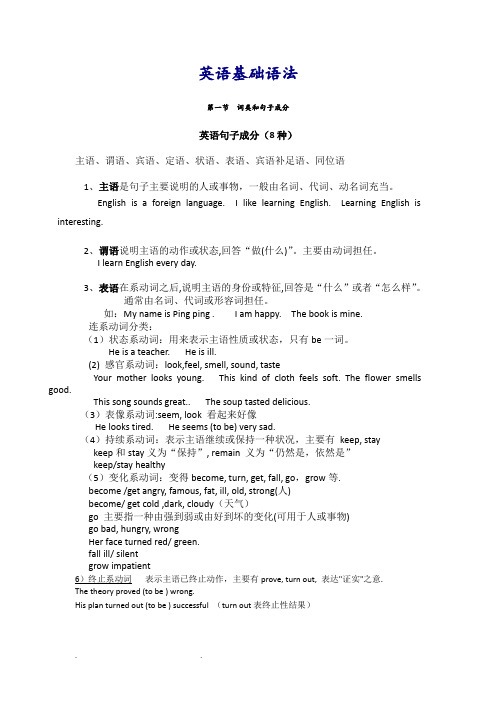
英语基础语法第一节词类和句子成分英语句子成分(8种)主语、谓语、宾语、定语、状语、表语、宾语补足语、同位语1、主语是句子主要说明的人或事物,一般由名词、代词、动名词充当。
English is a foreign language. I like learning English. Learning English is interesting.2、谓语说明主语的动作或状态,回答“做(什么)”。
主要由动词担任。
I learn English every day.3、表语在系动词之后,说明主语的身份或特征,回答是“什么”或者“怎么样”。
通常由名词、代词或形容词担任。
如:My name is Ping ping . I am happy. The book is mine.连系动词分类:(1)状态系动词:用来表示主语性质或状态,只有be一词。
He is a teacher. He is ill.(2) 感官系动词:look,feel, smell, sound, tasteYour mother looks young. This kind of cloth feels soft. The flower smells good.This song sounds great.. The soup tasted delicious.(3)表像系动词:seem, look 看起来好像He looks tired. He seems (to be) very sad.(4)持续系动词:表示主语继续或保持一种状况,主要有keep, stay keep和stay义为“保持”, remain 义为“仍然是,依然是”keep/stay healthy(5)变化系动词:变得become, turn, get, fall, go,grow等.become /get angry, famous, fat, ill, old, strong(人)become/ get cold ,dark, cloudy(天气)go 主要指一种由强到弱或由好到坏的变化(可用于人或事物)go bad, hungry, wrongHer face turned red/ green.fall ill/ silentgrow impatient6)终止系动词表示主语已终止动作,主要有prove, turn out, 表达"证实"之意.The theory proved (to be ) wrong.His plan turned out (to be ) successful (turn out表终止性结果)4、宾语表示及物动词的对象或结果,回答做的是“什么”。
英语零基础语法大全

英语零基础语法大全一、名词(Noun)名词是用来指称人、事物、地点和抽象概念的词。
在英语中,名词可以分为可数名词和不可数名词。
1. 可数名词(Countable Nouns)可数名词可以用单数和复数形式来表示,单数形式通常用来表示一个,而复数形式用来表示多个。
1.1 单数名词(Singular Nouns)•例:a book(一本书)•例:a cat(一只猫)1.2 复数名词(Plural Nouns)•例:books(书,复数形式)•例:cats(猫,复数形式)2. 不可数名词(Uncountable Nouns)不可数名词表示的是无法用单数或复数形式来表示的物质、概念或抽象事物。
•例:water(水)•例:information(信息)二、动词(Verb)动词是表示一个动作、状态或感觉的词语。
在英语中,动词可以分为及物动词和不及物动词。
1. 及物动词(Transitive Verbs)及物动词需要接受一个宾语才能完整表达含义。
•例:I read a book.(我读书。
)2. 不及物动词(Intransitive Verbs)不及物动词不需要接受宾语就能表达完整含义。
•例:She sleeps.(她睡觉。
)三、形容词(Adjective)形容词用来描述名词或代词的特征或性质。
•例:a beautiful flower(一朵美丽的花)四、副词(Adverb)副词用来修饰动词、形容词或其他副词,表示时间、位置、原因等信息。
•例:She sings beautifully.(她唱得很美。
)五、代词(Pronoun)代词用来代替名词,帮助避免重复使用名词。
•例:He is my brother. He is very kind.(他是我的兄弟。
他非常友好。
)六、冠词(Article)冠词分为定冠词“the”和不定冠词“a”、“an”,用来限定名词的范围或特定性质。
•例:I have a cat. The cat is black.(我有一只猫。
(完整版)英语语法入门基础知识

语法基础知识目录一、字母与语音 (1)二、词法 (3)三、句法 (12)四、时态 (16)语法基础知识一、字母与语音ɔ 主要字母组合的发音字母组合发音例词aralcar,bar,far,star small [a:][ɔ:]ayea play [ei][i :][ei]tea,beat,read,eat break,great bread [e]eeei[i :][ei]bee,see,Lee,jeep eight oo[u ]cook,foot,look,classroom boot,food,gooes,room coat,boat,goat oil [u :]oaoiu [ə ]ɔ[ i ]ir:[ə ]bird ooroyow[ :]door ɔɔ[ i ]boy [au ][ əu ][au ]how Know ouor house [ə:][ə]work,world,worse doctor,visitor,tractor morning [ɔ:]er[ə]sister,brother,mother,father her,term [ə:]irəbird,shirt,third,girl beer,deer,cheer turn [ :][ ə]eeruri [ə:][e ə]eirereeartheir [εə][i ə]there,where hear,fear [εə][εə][θ][ð]pear,bear,wear chair,hair airththree,thirty,thin,thousand this,those,these,they chick,click,cock,clockck [k ]0给大家推荐一个英语微信群Empty Your Cup英语微信群是目前学习英语最有效的方法,群里都是说英语,没有半个中文,而且规则非常严格,是一个超级不错的英语学习环境,群里有好多英语超好的超牛逼的人,还有鬼佬和外国美眉。
英语基础语法知识整理

英语基础语法知识整理目录一、词的分类 (1)1、名词 (1)2、代词 (2)3、冠词 (3)4、数词 (3)5、形容词、副词 (4)6、介词 (5)二、基本句型 (5)1、主语+谓语 (5)2、主语+谓语+宾语 (5)3、主语+谓语+间接宾语+直接宾语 (6)4、主语+谓语+宾语+宾语补足语 (6)5、主语+系动词+表语 (6)三、英语主要时态 (6)1、一般现在时 (6)2、一般过去时 (7)3、现在进行时 (7)4、过去进行时 (7)5、一般将来时 (7)四、从句句型 (8)1、宾语从句 (8)2、状语从句 (9)3、定语从句 (9)一、词的分类1、名词(1)名词的可数与不可数可数名词指表示的人或事物可以用数来计量,它有单数与复数两种形式。
不可数名词指所表示的事物不能用数来计量。
物质名词与抽象名词一般无法用数目,来统计,都成为不可数名词。
不可数名词前一般不能用冠词a、an来表示数量,没有复数形式。
要表示“一个……”这一概念,就须加a piece of这一类短语。
要注意许多名词在汉语里看来是可数名词,在英语里却不可数。
如:chalk,paper,bread,rice,grass,news 等。
(2)名词复数的规则变化A.一般情况下加-s。
B.以s, x, ch, sh, 结尾的加-esC.以辅音字母加y结尾的改y为i再加-esD.以f,fe结尾的,去掉f或fe,变成v再加-es(3)名词的所有格A. 单数名词词尾加’s,复数名词词尾若没有s,也要加’s。
如:the worker's bike,the Children’ s ballB. 表示几个人共有一样东西,只需在最后一个人的名字后加’ s若表示各自所有,则需在各个名字后’ s。
如:This is Lucy and Licy’ s room.These are Kate's and jack’ s rooms.C. 如果是通过在词尾加—s构成的复数形式的名词,只加’。
英语最基础的语法都有哪些

英语最基础的语法都有哪些英语最基础的语法都有哪些对于英语来说,除了我们经常背的单词以外,语法是英语的主要部分,也是极为重要的一部分,那么关于英语最基础的语法你们都知道哪些呢?【一】英语最基础的语法S=主语,V=谓语,P=表语,O=宾语,o=间接宾语,C=宾语补足语) 在此句式中,v是不及物动词,又叫自动词(vi.)。
例如:Everybody laughed.大家都笑了。
在此句式中,v是系动词(link v.),常见的系动词有:look, seem,appear, sound, feel, taste, smell, grow, get, fall ill/asleep, stand/sit still, become, turn等。
例如:The story sounds interesting.这个故事听起来有趣。
在此句式中,v是及物动词(vt.),因此有宾语。
例如:I love apples.我喜欢苹果。
【二】、英语最基础的从句1、感叹句(感叹句是表示说话是的惊讶、喜悦、赞赏、愤怒等情绪的句子.感叹句所修饰的部分除动词外必须提到前面,句中的剩余部分用正常语序,句末要用感叹号.)2、反意问句(反意问句附在称述句后面,多称述句所叙述的事情提出相反的疑问.该句型的结构特征为:1、先肯定则后否定 2、先否定则后肯定.)3、There be句型(句中表示某时、某处有某人或某物的时候,常用该句型,起基本结构为There be+主语+其他成分,there在这样的结构中是个引导词,没有实际含义.)4、主谓一致(主谓一致是指谓语动词在人称和数上必须和主语一致.)5、复合句(复合句是由一个主句与一个或一个以上的从句所构成的.在复合句中,主句是句子的主体,从句则用来充当主句中的某一个成分.)6、名词性从句(指主语从句、宾语从句、表语从句、同位语从句而言,该从句在句中起名词的作用7、定语从句(在复合句中修饰名词、代词、动名词、介词短语的句子叫定语从句.)8、状语从句(有:地点状语从句、时间状语从句、原因状语从句、目的状语从句、结果状语从句、条件状语从句、让步状语从句、比较状语从句、方式状语从句.)9、倒装(倒装是一种语法手段.用于强调某一句子成分或出与一定句子结构的需要.最基本的就是主谓倒装.倒装分为两种:一种是将主语谓语完全颠倒过来,叫完全倒装;另一种是只将助动词移到主语之前叫做部分倒装.)【三】、英语基础语法的种类第一,静词法。
英语语法基础知识大全

英语语法基础知识大全一. 词法1. 名词(1)名词的可数与不可数可数名词指表示的人或事物可以用数来计量,它有单数与复数两种形式。
不可数名词指所表示的事物不能用数来计量。
物质名词与抽象名词一般无法用数目,来统计,都成为不可数名词。
不可数名词前一般不能用冠词a、an来表示数量,没有复数形式。
要表示“一个……”这一概念,就须加a piece of这一类短语。
要注意许多名词在汉语里看来是可数名词,在英语里却不可数。
如:chalk,paper,bread,rice,grass,news等。
(2)名词复数的规则变化a.一般情况下加-s。
b.以s, x, ch, sh, 结尾的加-esc.以辅音字母加y结尾的改y为i再加-esd.以f,fe结尾的,去掉f或fe,变成v再加-es(3)名词的所有格a. 单数名词词尾加’s,复数名词词尾若没有s,也要加’s。
如:the worker‘s bike,the children’ s ballb. 表示几个人共有一样东西,只需在最后一个人的名字后加’ s若表示各自所有,则需在各个名字后’ s。
如:this is lucy and licy’ s room.these are kate‘s and jack’ s rooms.c. 如果是通过在词尾加—s构成的复数形式的名词,只加’。
如:the students’ books,the girls’ blouses(另外:名词+of+名词名词是有生命的,我们就用’s结构来表示所有关系。
如果名词所表示的事物是无生命的,我们就要用名词+of+名词的结构来表示所有关系。
)2. 代词人称代词,物主代词,反身代词,指示代词,不定代词(1)人称代词第一人称单数i me my mine myself复数 we us our ours ourselves第二人称单数you you your yours yourself复数you you your yours yourselves第三人称单数he him his his himselfshe her her hers herselfit it its its itself复数they them their theirs themselves(2)物主代词物主代词的用法:形容词性物主代词后面一定要跟上一个名词;名词性物主代词可作主语、表语、宾语。
《英语语法基础知识大全_(全文)》.doc

英语语法基础知识第1课:1、be (是)动诃的用法:am接I; is接第三人称单数,即除you、I夕卜;are接表示多个人或事物,即复数。
(我是am,你是are, is连接它、她、他,单数is,复数are)。
2、not 是表示否定的词:不是的表达,am not, is not (isn' t), are not (£iren, t)a3、“一•个”和“几个”的问题:“一个”是a+名词;“多个”是名词后面加s。
4、以无音开头(如O、E等),前面的冠词用an。
第2课:1、及物动词与不及物动词的区别:及物动词后面接宾语;而不及物动词后面不接宾语。
女|[ I like ice cream , It hurts o2、主语是he、she、i(和单数名词时,动词要发生第三人称的变化,即加s。
3、否定的用法:在动词之询加do not或does not。
I、You和复数名词做主语吋,否定就用do not;凡是单数名称和he、she、it做主语,否定就用does note第3课1 > my (我的)、your (你的)、his (他的)、her (她的)、their (他们的)、our (我们的)、its (它的)+ 名诃,如my love, your love 。
2、..................................... 名词所有格形式为:名词+' S,表示“的”,如Sophie' s world, children? sDay,Japan' s tomorrow o 3、.................................................. 用名词+of+名词,一般用在无生命的名词上,表示“...................................... 的’’,The sound of music(音乐之声)。
英语语法基础知识

英语语法基础知识☆词类1. 十大词类实词:可以在句子里面充当成分,可以独立出现1.名词n. 表示人和事物的名称,作主语、宾语等2.代词pron. 代替名词数词等,作主语、宾语等3.动词v. 表示动作,做谓语4.形容词adj. 表示人或事物的特征,作定语、表语,译作“….的”5.副词adv. 表示动作特征或性状特征,修饰动词,形容词或其它副词,做状语,译作“…地”6.数词num. 表示数目或顺序,做主语、宾语、表语、定语等虚词:不能独立出现7.冠词art. 用在名词前帮助说明其意义,a / an / the8.介词prep. 用在名词,代词等前面,说明它与别的词之间的关系9.连词conj. 用来连接词与词或句与句10.感叹词interj. 表示说话时的感情或口气☆句子成分1. 句子成分概述组成句子的各个部分叫做句子的成分,既:主语、谓语、表语、宾语、定语、状语、宾语补足语。
主语和谓语是句子的主体部分。
1.主要成分:主语、谓语(必须有)2.特定成分:宾语、表语、补语(在某种特定的句型里面出现)3.附加成分:定语、状语(可有可无,可多可少)2、句子各种成分的含义理解:1)、主语:句子的主角,一个句子在说或讨论谁(啥),谁(啥)就是主语。
主语一般放在句首。
(在“主+谓+宾”的句型结构中,主语是动作的执行者,宾语是动作的承受者。
)E.g:Tom is a doctor.My father and my mother are teachers.Today is my birthday.I can see a desk in the room.Watching TV too much is bad for your eyes.Beijing is a good place to visit.2)、谓语:动词作谓语,谓语必须是动词(be/情态/实意动词)。
一般放在主语的后面。
谓语要跟前面的主语在“人称”和“数”上保持一致,这叫主谓一致。
英语语法基础知识大全基本语法
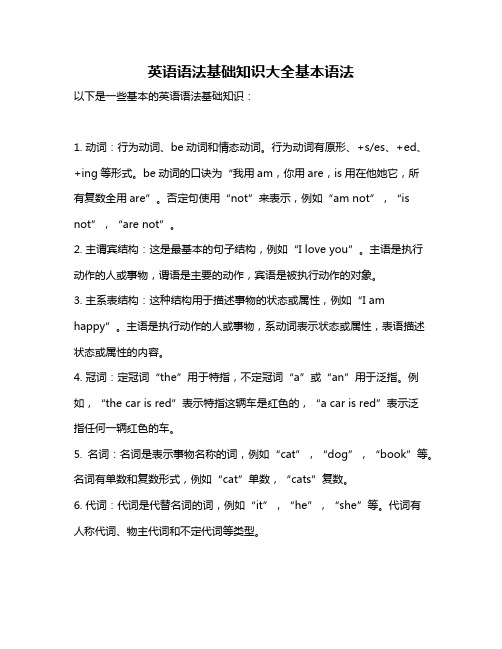
英语语法基础知识大全基本语法以下是一些基本的英语语法基础知识:1. 动词:行为动词、be动词和情态动词。
行为动词有原形、+s/es、+ed、+ing等形式。
be动词的口诀为“我用am,你用are,is用在他她它,所有复数全用are”。
否定句使用“not”来表示,例如“am not”,“is not”,“are not”。
2. 主谓宾结构:这是最基本的句子结构,例如“I love you”。
主语是执行动作的人或事物,谓语是主要的动作,宾语是被执行动作的对象。
3. 主系表结构:这种结构用于描述事物的状态或属性,例如“I am happy”。
主语是执行动作的人或事物,系动词表示状态或属性,表语描述状态或属性的内容。
4. 冠词:定冠词“the”用于特指,不定冠词“a”或“an”用于泛指。
例如,“the car is red”表示特指这辆车是红色的,“a car is red”表示泛指任何一辆红色的车。
5. 名词:名词是表示事物名称的词,例如“cat”,“dog”,“book”等。
名词有单数和复数形式,例如“cat”单数,“cats”复数。
6. 代词:代词是代替名词的词,例如“it”,“he”,“she”等。
代词有人称代词、物主代词和不定代词等类型。
7. 形容词:形容词是描述名词或代词性质或特征的词,例如“big”,“beautiful”,“happy”等。
形容词有原级、比较级和最高级形式。
8. 副词:副词是描述动词、形容词或其他副词的词,例如“fast”,“slowly”,“happily”等。
副词有地点副词、时间副词、方式副词等类型。
9. 介词:介词用于表示名词或代词与动词之间的关系,例如“in”,“on”,“under”等。
介词后面通常跟名词或代词。
10. 连词:连词用于连接两个或多个句子或分句,例如“and”,“but”,“or”等。
连词有并列连词和从属连词等类型。
以上是一些基本的英语语法基础知识,了解这些基础知识有助于更好地理解和运用英语语言。
英语十大基础语法知识点
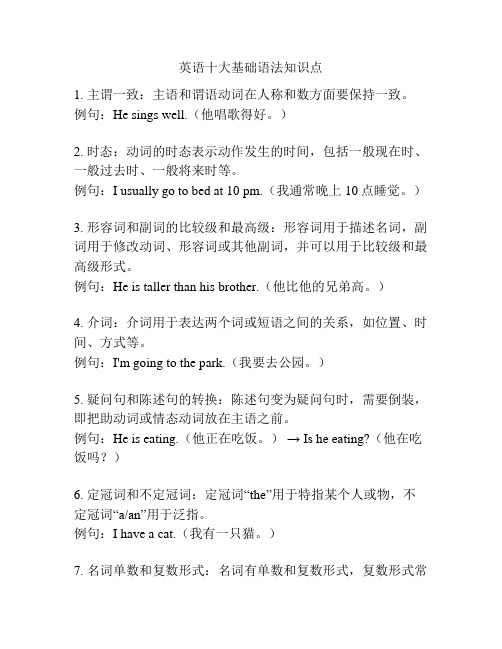
英语十大基础语法知识点1. 主谓一致:主语和谓语动词在人称和数方面要保持一致。
例句:He sings well.(他唱歌得好。
)2. 时态:动词的时态表示动作发生的时间,包括一般现在时、一般过去时、一般将来时等。
例句:I usually go to bed at 10 pm.(我通常晚上10点睡觉。
)3. 形容词和副词的比较级和最高级:形容词用于描述名词,副词用于修改动词、形容词或其他副词,并可以用于比较级和最高级形式。
例句:He is taller than his brother.(他比他的兄弟高。
)4. 介词:介词用于表达两个词或短语之间的关系,如位置、时间、方式等。
例句:I'm going to the park.(我要去公园。
)5. 疑问句和陈述句的转换:陈述句变为疑问句时,需要倒装,即把助动词或情态动词放在主语之前。
例句:He is eating.(他正在吃饭。
)→ Is he eating?(他在吃饭吗?)6. 定冠词和不定冠词:定冠词“the”用于特指某个人或物,不定冠词“a/an”用于泛指。
例句:I have a cat.(我有一只猫。
)7. 名词单数和复数形式:名词有单数和复数形式,复数形式常常在词尾加-s或-es。
例句:I have two dogs.(我有两只狗。
)8. 反义词:反义词是一对意义相反的词,如大-小、高-低。
例句:The weather is hot today.(今天天气很热。
)9. 反身代词:反身代词用于表示动作的对象是主语自己。
例句:He hurt himself.(他伤到了自己。
)10. 形容词性物主代词和名词性物主代词:形容词性物主代词用于修饰名词,名词性物主代词则在句子中作为名词。
例句:This is my book.(这是我的书。
)。
英语语法的基础知识

英语语法的基础知识英语语法入门基础篇大全一、英语语句基本结构分析:主谓宾结构:主语:可以作主语的成分有名词(如boy),主格代词(如you),动词不定式,动名词等。
主语一般在句首。
注意名词单数形式常和冠词不分家!谓语:谓语由动词构成,是英语时态、语态变化的主角,一般在主语之后。
不及物动词(vi.)没有宾语,形成主谓结构,如:We e.宾语:宾语位于及物动词之后,一般同主语构成一样,不同的是构成宾语的代词必须是‘代词宾格’,如:me,him,them等例:The boy needs a pen.主语the boy,谓语needs(need的第三人称单数形式),宾语a pen.主系表结构:主语:同‘主谓宾’结构。
联系动词(Link verb):be动词(am,is,are,was,were,have been);其他联系动词如:e成为,turn变成,go变。
其特点是联系动词与其后的表语没有动宾关系,表语多为形容词或副词,既,不可能是宾语。
表语:说明主语的状态、性质、等。
可为形容词、副词、名词、代词、不定式、分词。
当联系动词不是be,而其后是名词和代词时,多表达‘转变为’之意,注意与动宾关系的区别。
感官动词多可用作联系动词:look well/面色好,sound nice/听起来不错,feel good/感觉好,smell bad/难闻例:Tom is a boy.(Tom是个男孩)/主语为Tom,系词为be动词的第三人称单数is,表语为a boyThere be 结构:There be 表示‘存在有’。
这里的there没有实际意义,不可与副词‘there那里’混淆。
此结构后跟名词,表示‘(存在)有某事物’试比较:There is a boy there.(那儿有一个男孩。
)/前一个there无实意,后一个there为副词‘那里’。
二、定语:定语是对名词或代词起修饰、限定作用的词、短语或句子,汉语中常用‘。
英语语法基础知识大全
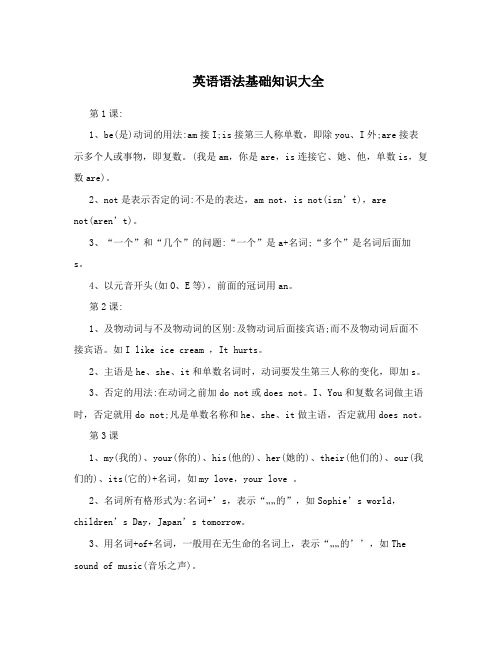
英语语法基础知识大全第1课:1、be(是)动词的用法:am接I;is接第三人称单数,即除you、I外;are接表示多个人或事物,即复数。
(我是am,你是are,is连接它、她、他,单数is,复数are)。
2、not是表示否定的词:不是的表达,am not,is not(isn’t),arenot(aren’t)。
3、“一个”和“几个”的问题:“一个”是a+名词;“多个”是名词后面加s。
4、以元音开头(如O、E等),前面的冠词用an。
第2课:1、及物动词与不及物动词的区别:及物动词后面接宾语;而不及物动词后面不接宾语。
如I like ice cream ,It hurts。
2、主语是he、she、it和单数名词时,动词要发生第三人称的变化,即加s。
3、否定的用法:在动词之前加do not或does not。
I、You和复数名词做主语时,否定就用do not;凡是单数名称和he、she、it做主语,否定就用does not。
第3课1、my(我的)、your(你的)、his(他的)、her(她的)、their(他们的)、our(我们的)、its(它的)+名词,如my love,your love 。
2、名词所有格形式为:名词+’s,表示“……的”,如Sophie’s world,children’s Day,Japan’s tomorrow。
3、用名词+of+名词,一般用在无生命的名词上,表示“……的’’,如The sound of music(音乐之声)。
第4课1、“have”和“there be”翻译成汉语都可以用一个“有”字来表示,但have是指主观的“所有、拥有”,而there be则是指客观的“存在,某处有某物”。
2、There be的单复数变化与be的变化规则相同,取决于后面所接的主语。
主语为单数,就变成there is,主语是复数,就变成there are。
3、“have”在第三人称单数时变成“has”。
英语基础语法和词汇

英语基础语法和词汇一、基础语法。
1. 名词(noun,[naʊn])- 定义:表示人、事物、地点、抽象概念等的名称。
- 分类:- 可数名词(countable noun):有单复数形式,如book([bʊk]) - books。
- 不可数名词(uncountable noun):没有复数形式,如water(['wɔːt ə]),milk([mɪlk])。
- 名词所有格:- 表示所属关系,有's形式,如Tom's book(汤姆的书)。
2. 动词(verb,[vɜːb])- 定义:表示动作或状态。
- 分类:- 及物动词(transitive verb,[ˈtrænzətɪv vɜːb]):后面必须跟宾语,如I love apples(我爱苹果),“love”是及物动词,“apples”是宾语。
- 不及物动词(intransitive verb,[ɪnˈtrænzətɪv vɜːb]):后面不跟宾语,如He runs fast(他跑得快),“runs”是不及物动词。
- 动词的时态:- 一般现在时:表示经常或习惯性的动作或状态。
主语为第三人称单数时,动词要加 -s或 -es,如He likes reading(他喜欢阅读)。
- 一般过去时:表示过去某个时间发生的动作或存在的状态,动词一般加 -ed (规则动词),如I played football yesterday(我昨天踢足球了)。
- 一般将来时:表示将来要发生的动作或存在的状态,结构为will+动词原形或be going to+动词原形,如He will go to school tomorrow(他明天将去上学)。
3. 形容词(adjective,[ˈædʒɪktɪv])- 定义:用来修饰名词,表示人或事物的特征。
- 位置:一般放在名词前面,如a beautiful flower(一朵美丽的花),“beautiful”([ˈbjuːtɪfl])是形容词,修饰“flower”。
英语语法基础知识总结
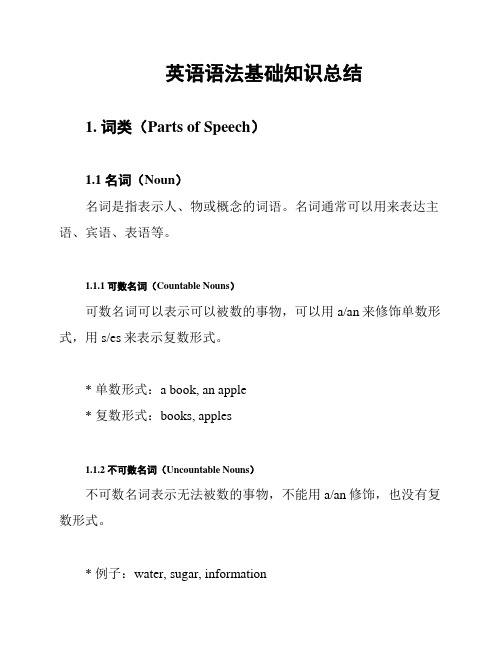
英语语法基础知识总结1. 词类(Parts of Speech)1.1 名词(Noun)名词是指表示人、物或概念的词语。
名词通常可以用来表达主语、宾语、表语等。
1.1.1 可数名词(Countable Nouns)可数名词可以表示可以被数的事物,可以用a/an来修饰单数形式,用s/es来表示复数形式。
* 单数形式:a book, an apple* 复数形式:books, apples1.1.2 不可数名词(Uncountable Nouns)不可数名词表示无法被数的事物,不能用a/an修饰,也没有复数形式。
* 例子:water, sugar, information1.2 动词(Verb)动词用以表示动作或状态。
动词可以分为及物动词和不及物动词。
1.2.1 及物动词(Transitive Verbs)及物动词需要接受一个宾语,来完成其动作的意义。
* 例子:I read a book.(我读一本书。
)1.2.2 不及物动词(Intransitive Verbs)不及物动词不需要接受宾语,它的意义可以独立完成。
* 例子:She sleeps.(她睡觉。
)2. 时态(Tenses)2.1 现在时态(Present Tense)现在时态表示目前正在进行或经常发生的动作。
2.1.1 现在进行时(Present Continuous)现在进行时表示正在进行的动作,使用"am/is/are + 动词-ing"形式构成。
* 例子:I am studying.(我正在研究。
)2.2 过去时态(Past Tense)过去时态表示过去发生的动作。
2.2.1 一般过去时(Simple Past)一般过去时表示在过去某个时间发生的动作,通常用动词的过去式形式表达。
* 例子:She played piano yesterday.(她昨天弹了钢琴。
)2.2.2 过去进行时(Past Continuous)过去进行时表示过去某一时间正在进行的动作,使用"was/were + 动词-ing"形式构成。
英语基础语法知识总结大全
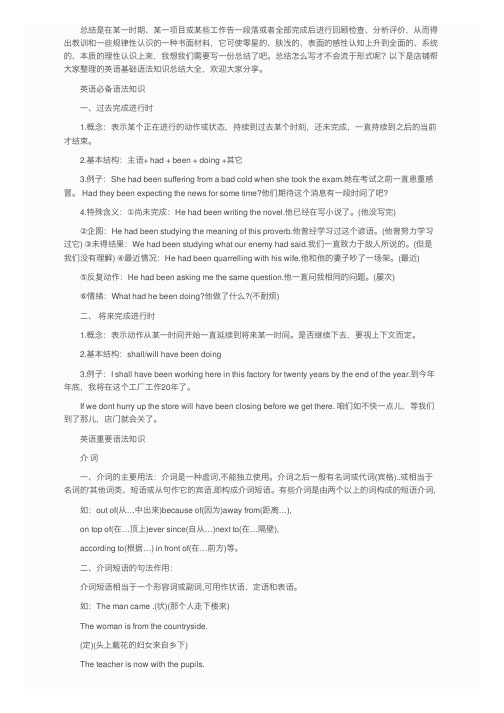
总结是在某⼀时期、某⼀项⽬或某些⼯作告⼀段落或者全部完成后进⾏回顾检查、分析评价,从⽽得出教训和⼀些规律性认识的⼀种书⾯材料,它可使零星的、肤浅的、表⾯的感性认知上升到全⾯的、系统的、本质的理性认识上来,我想我们需要写⼀份总结了吧。
总结怎么写才不会流于形式呢?以下是店铺帮⼤家整理的英语基础语法知识总结⼤全,欢迎⼤家分享。
英语必备语法知识 ⼀、过去完成进⾏时 1.概念:表⽰某个正在进⾏的动作或状态,持续到过去某个时刻,还未完成,⼀直持续到之后的当前才结束。
2.基本结构:主语+ had + been + doing +其它 3.例⼦:She had been suffering from a bad cold when she took the exam.她在考试之前⼀直患重感冒。
Had they been expecting the news for some time?他们期待这个消息有⼀段时间了吧? 4.特殊含义:①尚未完成:He had been writing the novel.他已经在写⼩说了。
(他没写完) ②企图:He had been studying the meaning of this proverb.他曾经学习过这个谚语。
(他曾努⼒学习过它) ③未得结果:We had been studying what our enemy had said.我们⼀直致⼒于敌⼈所说的。
(但是我们没有理解) ④最近情况:He had been quarrelling with his wife.他和他的妻⼦吵了⼀场架。
(最近) ⑤反复动作:He had been asking me the same question.他⼀直问我相同的问题。
(屡次) ⑥情绪:What had he been doing?他做了什么?(不耐烦) ⼆、将来完成进⾏时 1.概念:表⽰动作从某⼀时间开始⼀直延续到将来某⼀时间。
英语语法基础入门
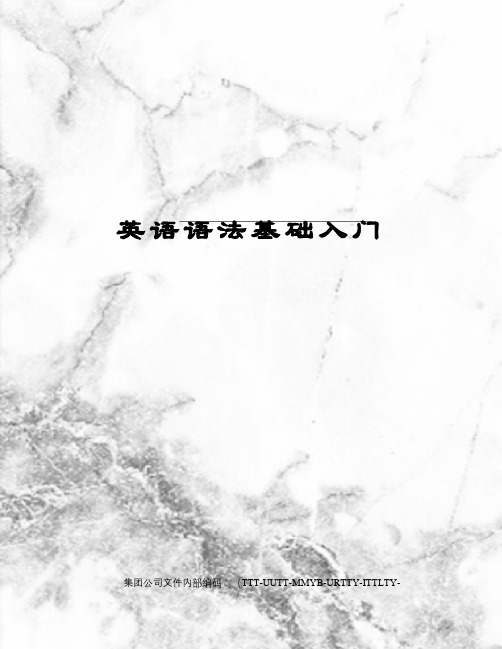
英语语法基础入门集团公司文件内部编码:(TTT-UUTT-MMYB-URTTY-ITTLTY-英语语法基础入门一、词类和句子成分根据词的形式、意义及其在句中的功用将词分为若干类,叫做词类。
一个句子由各个功用不同的部分所构成,这些部分叫做句子成分。
学一个词,要学它的发音、拼法、意义,也要记它的词类;更重要的是要了解它和其他词的关系,及其在句中作什么句子成分。
如China is in East Asia(中国位于东亚)一句中的China这个单词所属的词类是名词,在句子中作主语。
(一)词类(parts of speech)英语的词通常分为十大类:1)名词(noun,缩写为n.)是人和事物的名称,如pen(钢笔),English(英语),life(生活)。
2)代词(pronoun,缩写为pron.)是用来代替名词的词,如we(我们),his(他的),all(全部)。
3)形容词(adjective,缩写为adj.)用来修饰名词,如great(伟大的),honest(诚实的),difficult(困难的)。
4)数词(numeral,缩写为num.)是表示"多少"和"第几"的词,如four(四),eighteen(十八),first(第一),eighth(十八),hundred(一百)。
5)动词(verb,缩写为v)表示动作和状态,如write(写),walk(行走),think(想)。
6)副词(adverb,缩写为。
adv.)是修饰动词、形容词和副词的词,如quickly(快),often(经常),very(很)。
7)冠词(article,缩写为art.)说明名词所指的人或物的词,如a,an(一个),the(这,那)。
8)介词(preposition,缩写为prep.)表示名词(或代词)与句子里其它词的关系,如from(从),in(在…内),between(在…之间)。
英语语法基础知识

英语语法基础知识英语语法入门基础篇大全篇一一、英语语句基本结构分析:主谓宾结构:主语:可以作主语的成分有名词(如boy),主格代词(如you),动词不定式,动名词等。
主语一般在句首。
注意名词单数形式常和冠词不分家!谓语:谓语由动词构成,是英语时态、语态变化的主角,一般在主语之后。
不及物动词(vi.)没有宾语,形成主谓结构,如:We come.宾语:宾语位于及物动词之后,一般同主语构成一样,不同的是构成宾语的代词必须是‘代词宾格’,如:me,him,them等例:The boy needs a pen.主语the boy,谓语needs(need的第三人称单数形式),宾语a pen.主系表结构:主语:同‘主谓宾’结构。
联系动词(Link verb):be动词(am,is,are,was,were,have been);其他联系动词如:become 成为,turn变成,go变。
其特点是联系动词与其后的表语没有动宾关系,表语多为形容词或副词,既,不可能是宾语。
表语:说明主语的状态、性质、等。
可为形容词、副词、名词、代词、不定式、分词。
当联系动词不是be,而其后是名词和代词时,多表达‘转变为’之意,注意与动宾关系的区别。
感官动词多可用作联系动词:look well/面色好,sound nice/听起来不错,feel good/感觉好,smell bad/难闻例:Tom is a boy.(Tom是个男孩)/主语为Tom,系词为be动词的第三人称单数is,表语为a boyThere be 结构:There be 表示‘存在有’。
这里的there没有实际意义,不可与副词‘there那里’混淆。
此结构后跟名词,表示‘(存在)有某事物’试比较:There is a boy there.(那儿有一个男孩。
)/前一个there无实意,后一个there 为副词‘那里’。
二、定语:定语是对名词或代词起修饰、限定作用的词、短语或句子,汉语中常用‘……的’表示。
- 1、下载文档前请自行甄别文档内容的完整性,平台不提供额外的编辑、内容补充、找答案等附加服务。
- 2、"仅部分预览"的文档,不可在线预览部分如存在完整性等问题,可反馈申请退款(可完整预览的文档不适用该条件!)。
- 3、如文档侵犯您的权益,请联系客服反馈,我们会尽快为您处理(人工客服工作时间:9:00-18:30)。
英语基础语法时态是英语中一个重要的语法畴,它表示不同时间发生的动作或存在的状态以及动作发生或存在的方式。
动作发生的时间可分为现在、过去、将来和过去将来四种形式,动作发生的方式可分为一般、完成、进行和完成进行四种形式。
将时间形式和动作方式结合起来,就构成了以下16种时态形式(以do为例):【注】构成时态的助动词be (is, am, are), have (has), shall, will 等需根据主语的变化来选择。
英语基础语法:一般现在时一、构成一般现在时除主语是第三人称单数时谓语动词要加s外,一律用动词原形。
二、用法■一般现在时表示经常性或习惯性的动作,常与表示频度的时间状语every day, usually, always, often, sometimes, on Sunday等连用。
如:I go to school at 6 every morning. 每天早上我七点去上学。
■一般现在时表示客观存在及普遍真理。
如:Summer follows spring. 春天之后是夏天。
The sun rises in the east. 太阳从升起。
注意:此种用法即使出现在过去的语境中,仍用一般现在时。
如:I learned that the earth goes around the sun when I was in primary school. 我在小学就学过地球是围绕太阳转的。
■一般现在时表示格言或警句。
如:Pride goes before a fall. 骄者必败。
■一般现在时表示目前的情况或状态。
如:I am a teacher. 我是教师。
Peter writes good Chinese but does not speak well. 彼得汉语写得不错,讲的可不行。
■以here, there等开始的倒装句,表示动作正在进行。
如:Here comes the bus. = The bus is coming. 车来了。
There goes the bell. = The bell is ringing. 铃响了。
■在下列情况下表示将来:1. 在状语从句中用一般现在时代替一般将来时。
如:I will give it to him as soon as I see him. 我一看见他就交给他。
He will come if you invite him. 如果你请他,他会来的。
Suppose he doesn’t agree,what shall we do?假如他不同意,那怎么办?I shall do as I please. 我高兴怎么做就怎么做。
He will continue the work no matter what happens. 不管发生什么情况他都要继续这项工作。
2. 在the more…the more …(越……越……) 句型中,前者通常用一般现在时代替一般将来时,因为前者相当于条件状语从句。
如:The harder you study, the better results you will get. 你学习越努力,成绩就会越好。
3. 在make sure (certain) , see to it, mind, care, matter后的宾语从句的谓语动词用一般现在时代替一般将来时。
如:See to it that you are not late again. 注意别再迟到了(from .yygrammar.)。
4. 表示按计划或时间表将要发生的动作,通常有表示将来的时间状语。
如:The plane takes off at 11:30 and arrives in Shanghai at l:20. 飞机十一点半起飞,一点二十分抵达。
注:只限于少数动词能这样用,如 begin, start, , end, finish, stop, go, come, leave, sail, arrive, return, close, open 等。
英语基础语法:一般过去时一、构成方法一般过去时用动词的过去式构成,即在动词原形后加ed。
二、用法说明■表示在过去某个时间所发生的动作或所处的状态。
常与yesterday, last week, in 1989, just now, a moment ago, the other day等连用。
如:He was here just now. 他刚才还在这里。
What did you do yesterday? 你昨天做了什么事?■在过去一段时间的经常性或习惯性动作。
如:We often played together when we were children. 我们小时候常在一起玩。
注:表示过去经常发生的动作还可用used to 和would。
如:He used to smoke a lot, but he doesn’t now. 他过去经常抽烟,但现在不抽了。
Whenever we were in trouble, he would help us. 每当我们遇到困难,他都会帮助我们。
■表示主语过去的特征或性格。
如:At that time she was very good at English. 那时她英语学得很好。
■用在状语从句中表示过去将来。
如:He said he would wait until they came back.■一般过去时有时可以表示现在,多与 want, hope, wonder, think, intend 等动词连用,使语气更委婉。
如:I wondered if you could help me. 不知你能不能帮我一下。
有时用一般过去时也是时态一致的需要。
如:I didn’t know you were here. 没想到你在这里。
注意:1. 表示一系列的动作,尽管有先后,都用一般过去时,最后两个动词之间用and连结。
如:He opened the door, rushed out and then disappeared. 他打开门,冲了出去,然后就消失了。
2. 注意在语境中理解“我刚才/原来还不……”。
如:—Your phone number again? I didn’t quite catch it. —It’s 2566666. 请再说一次你的,好吗?我刚才没听清楚。
是2566666。
英语基础语法:现在进行时一、构成方法现在进行时由 am/is/are 加现在分词构成。
二、用法说明■表示此时此刻或现阶段正在进行的动作。
如:They’re having a meeting. 他们在开会。
I’m studying at an evening school. 我在上夜校。
■表示计划或安排好了的将来动作,常与一个表示将来的时间状语连用。
如:Mike is coming home on Thursday. 迈克星期四回来。
They’re having a party next week. 下星期他们将开一个晚会。
注:表示安排将要做的事,人作主语宜用现在进行时,事物作主语,宜用一般现在时。
试比较:I’m not going out this evening. 今晚我不准备出去。
(不宜说I don’t…)The concert starts at 7: 30. 音乐会七点半开始。
■现在进行时与always, often, forever等连用表示赞扬、厌烦等语气。
如:You’re always interrupti ng me! 你老打断我的话!(抱怨)My father is always losing his car keys. 我爸老丢车钥匙。
(不满)She’s always helping people. 她老是帮助别人。
(赞扬)■现在进行时在时间和条件状语从句中,代替过去将来时。
如:He promised to buy me a computer if he got a raise. (from .yygrammar.)注意:像 be, think, understand, love, have, own, see, hear, find, belong to 等静态动词通常不用于进行时。
英语基础语法:过去进行时一、构成方法过去进行时由 was/were 加现在分词构成。
二、用法说明■表示在过去某一时刻或某一阶段正在发生的动作。
如:What were you doing this time yesterday? 昨天这个时候你在做什么?During the summer of 1999 she was travelling in Europe. 1999年夏天她在欧洲旅行。
■表示过去将来,多用于go, come, leave, start, take off等动词。
如:He said he was leaving for home in a day or two. 他说他一两天之就动身回家了。
■表示过去的经常动作,常与always,forever等连用,略带感****彩。
如:She was always thinking of others. 她老是想到别人。
(赞扬)She was forever complaining. 她老是抱怨。
(厌烦)■表示某个短暂性动作发生的背景。
如果主句谓语和从句谓语都发生在过去,动作时间长的用过去进行时,表达谈话背景;动作时间短的用一般过去时,表达新的信息。
如:I was reading the newspaper when the doorbell rang. 我正在看报,突然门铃响了。
Jim burnt his hand when he was cooking the dinner. 吉姆做饭时把手烫了。
I met Diana while I was shopping this morning. 我今早买东西时碰到了戴安娜。
■表示两个同时持续的动作。
如:I was doing my homework while he was listening to music. 我在做作业而他在听音乐。
■过去进行时可以表示客气的语气。
如:I was wondering if you could give me a lift. 不知我可否顺便搭你的车英语基础语法:将来进行时一、构成方法英语的将来进行时由 will be doing 构成。
二、用法说明■将来进行时表示在将来某个时间正在发生的动作。
如:At this time tomorrow, I’ll be taking a test. 明天这时我会在考试。
